Cyberbullying Statistics & Facts In The US 2024
Explore the latest cyberbullying stats, its disproportionate effects on various demographics, and preventive measures being employed nationwide.
Summary
Cyberbullying is an ever-growing problem on various social media platforms. The prevalence of being a victim of online bullying spans various demographics and is not exclusively a young person issue. In the past, traditional bullying behavior was expressed via face-to-face confrontation, often in the case of school bullying.
However, now that most high school students have internet access, social media cyberbullying is replacing traditional bullying,[1] and it can come with serious consequences. The negative impact of cyberbullying can manifest in exasperating underlying mental illnesses, and suicidal thoughts, giving rise to self-esteem issues which can lead to self-harm and can even drive someone to commit suicide.
Methodology
For our analysis of online harassment, we utilized related data from Statista – an online platform specialized in data gathering. We then used this to draw conclusions and correlations on the topic of social media cyberbullying. We analyzed statistics from the Pew Research Center, U.S. government statistics, the Anti-Defamation League or ADL, and The Gay and Lesbian Alliance Against Defamation or GLAAD.
This article will present shocking cyber bullying statistics and facts. It examines the disproportionate amount of cyberbullying endured by young people and various marginalized groups. It also examined cyberbullying laws enacted in an attempt to prevent cyberbullying. This type of cyberbullying law can prevent teens and other young people from becoming online harassment victims.
U.S. Internet Users Experienced Cyberbullying Statistic
- Based on a 2021 online survey[2] of 2,251 responders over the age of 18, 41% had experienced harassment.
- 35% experienced offensive name-calling online, and 26% of the respondents experienced purposeful embarrassment.
- 27% of the respondents had experienced severe harassment.
- Of those who experienced severe harassment, 18% had experienced physical threats, 12% experienced sexual harassment, 12% experienced sustained harassment, and 13% experienced stalking.
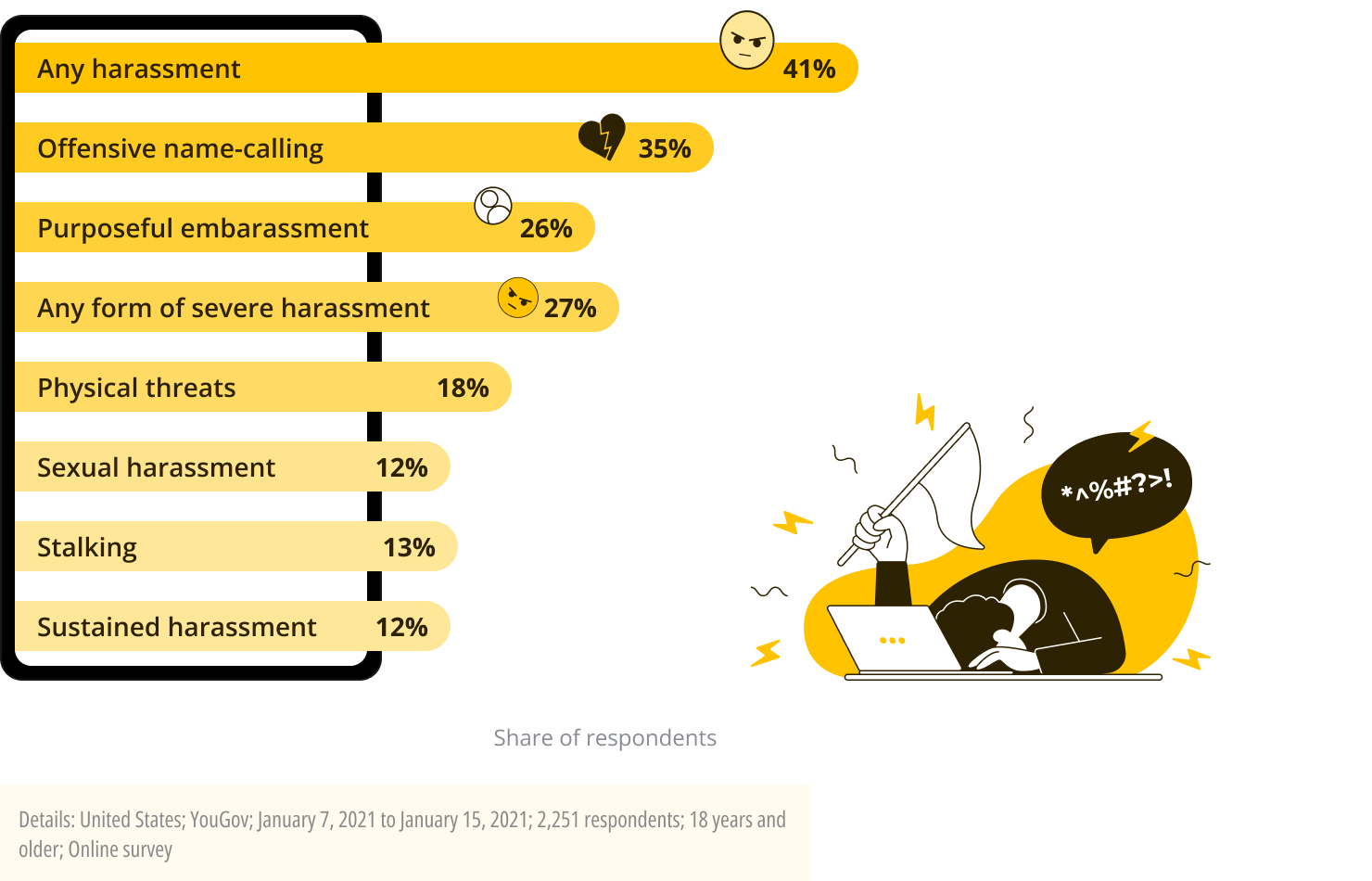
U.S. Cyber Bullying Environments
- 75%[3] of internet harassment victims in the United States had been cyberbullied via Facebook, one of the most popular social media platforms.
- Other social networking sites, such as Twitter and Instagram, ranked second, with 24% of respondents in the online survey stating that they had been harassed on each platform.
- 21% of surveyed respondents claimed to be a victim of cyberbullying on the YouTube platform.
Social Media companies, such as Facebook, have taken note of this harassment and have presented plans to stop cyberbullying on their platforms.[4]
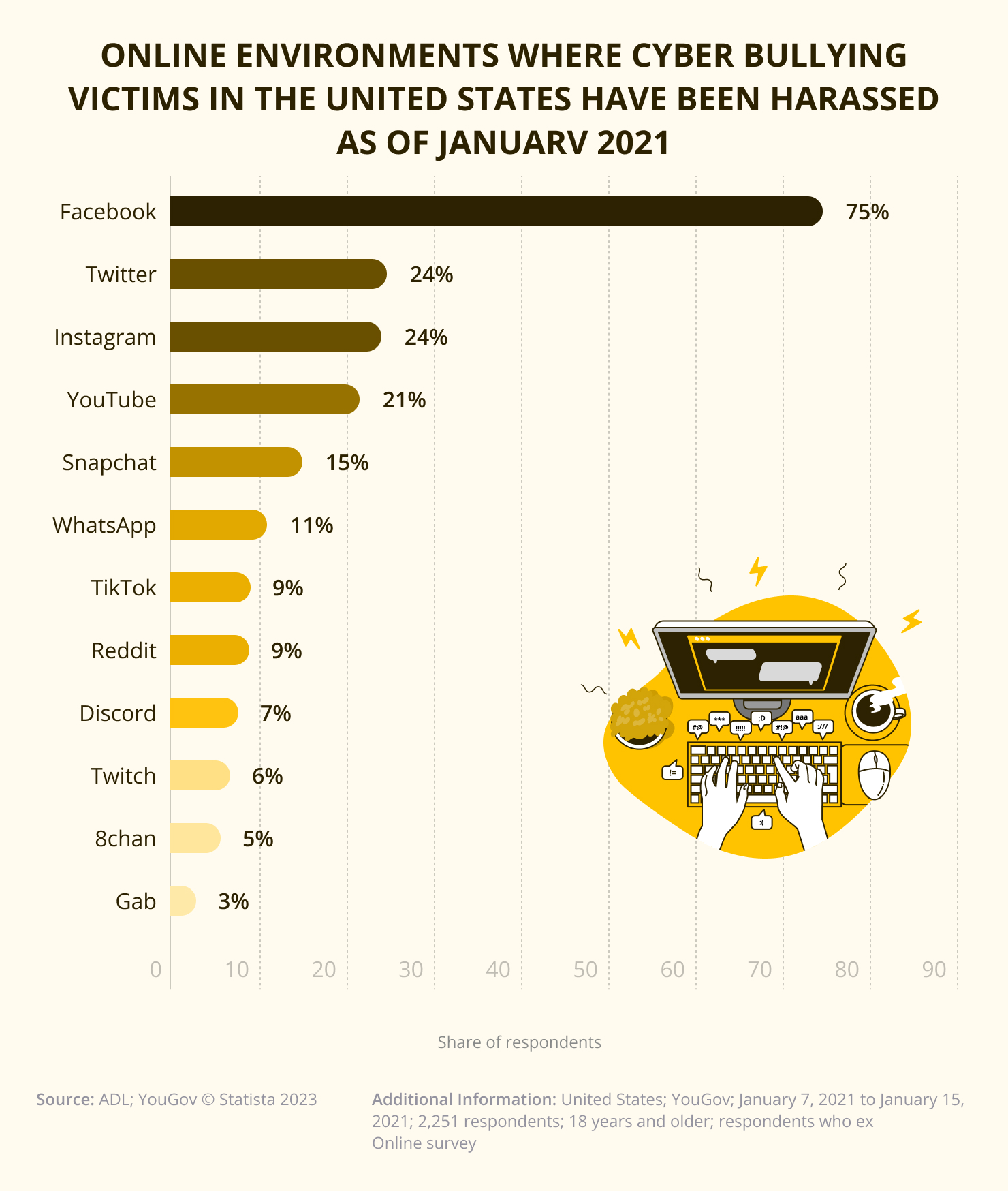
Trends In Cyberbullying
Based on a June 2021 survey conducted on children ages 13-17 which focused on the perception of cyberbullying since the Covid-19 pandemic concluded an increase in various types of trends.
- It was found that 26%[5] of respondents believed that they had been harassed more since the start of the pandemic.
- 42.5% of the respondents believe that there has been less harassment.
- 62.5% believe that they have cyberbullied people less since the start of the pandemic.
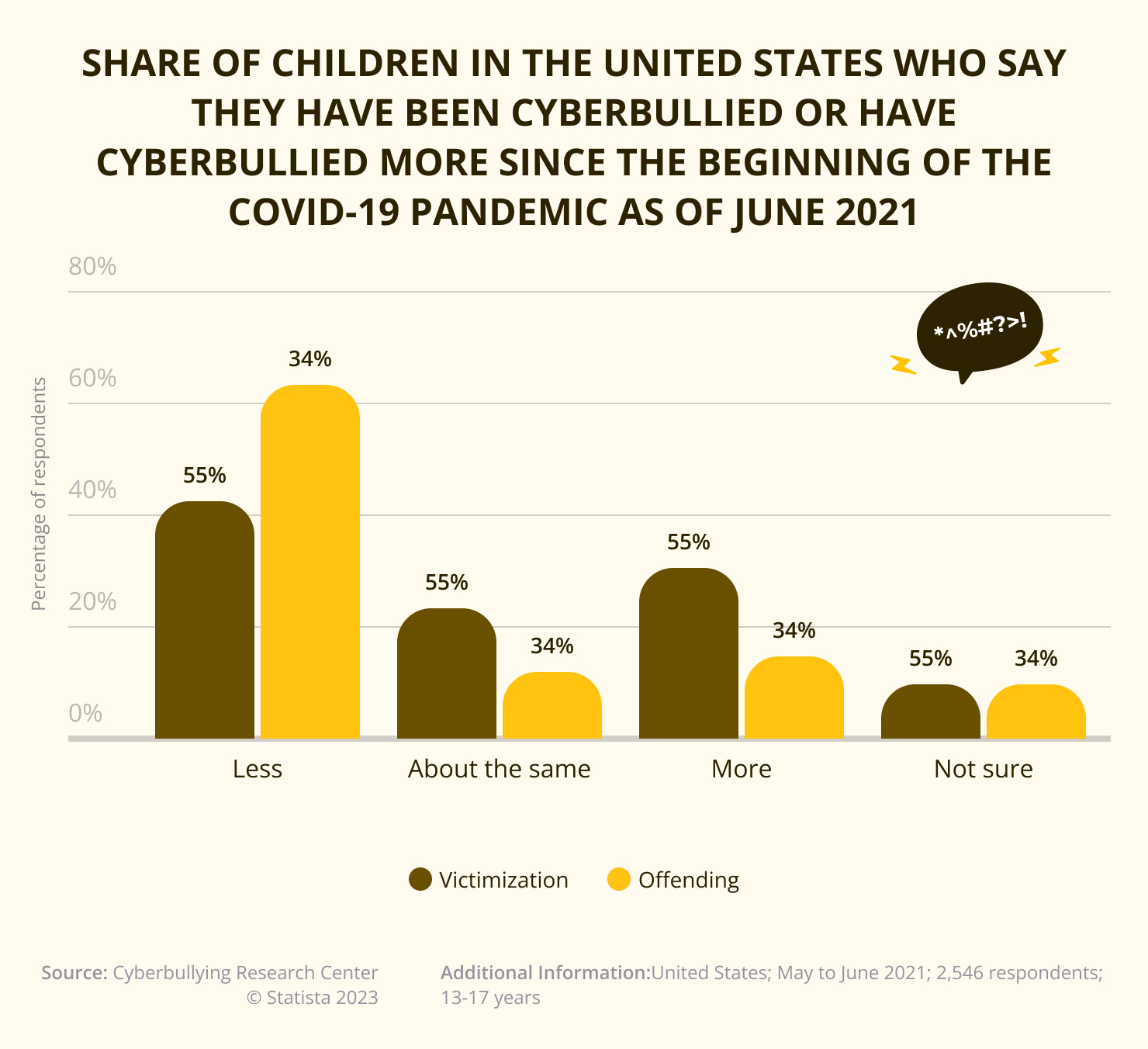
The Most Targeted Age Groups In Online Harassment
According to the Pew Research Center survey in September 2020:
- 64% of those between the ages of 18-29 had been bullied online.
- Within this age group, 48%[6] were reported to be victims of more severe behavior.
- Of those who are over the age of 65, only 21% had experienced cyberbullying.
Therefore, young adults tend to have a higher exposure to hurtful comments online. The reasons for such discrepancies can be due to more exposure to social media and online games within those age groups, which in turn would lead them to spend more time online. It is also less common for those over the age of 65 to spend prolonged time on social media platforms and, therefore, will likely have less exposure to social media cyberbullying.
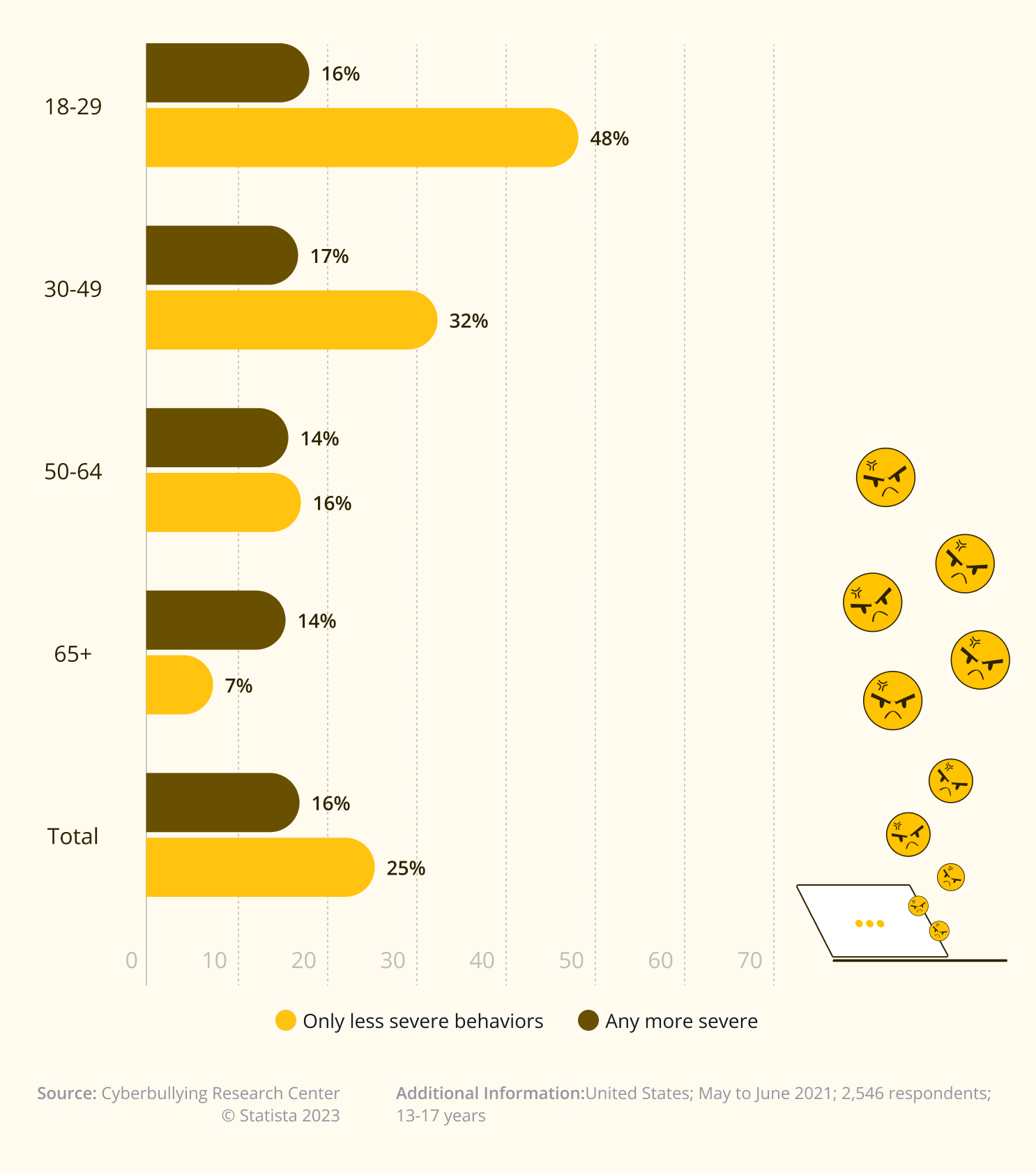
Who Experiences Harassment More Often?
In terms of determining who receives harassment more often, one must look at marginalized groups that are vulnerable to discriminatory harassment.
A study conducted by GLAAD in 2022, found that:
- 66%[7] of LGBTQ+ respondents experience cyberbullying.
- 54% reported severe harassment, such as physical threats, stalking, and sexual harassment.
Other groups that experience severe harassment online include:
- 31% of Asian American respondents
- 27% of African Americans
- 24% of Hispanics experiencing severe cyber harassment
- 23% of Jewish respondents and 26% of Muslim respondents reported severe harassment as well.
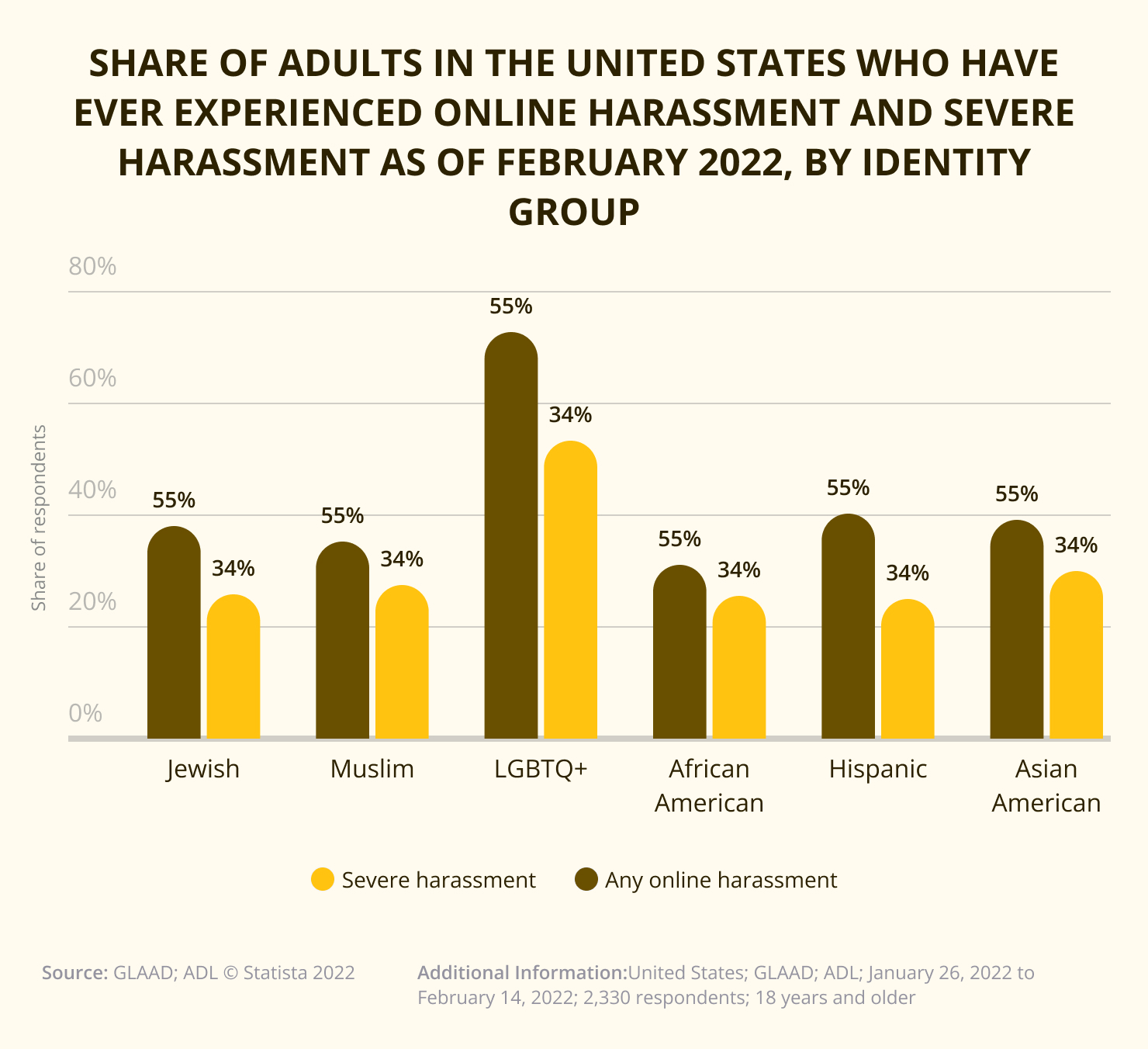
Most Common Types Of Online Harassment
By Gender
When it comes to differentiating between genders, it is important to note that the survey[8] of online harassment in September 2020 is based on data from women and men, non-binary was not included. Based on the 2020 survey, it can be extrapolated that men tend to experience bullying online more frequently than women.
- 38% of women reported harassment of any kind
- 43% of men reported any harassment.
There were several categories in which men continued to receive more harassment than women, such as being called offensive names.
- 35% of men experienced offensive name-calling
- 26% of women experienced that form of cyberbullying.
In terms of purposeful harassment:
- 28% of men and 25% of women reported that type of harassment.
As for physical threats online:
- 16% of men also tend to experience more physical threats online
However, women tend to experience three times the amount of sexual harassment online than men.
When it comes to sustained harassment, both genders tend to be equal in their rates:
- 11% of men report sustained harassment
- 10% of women reported that type of harassment.
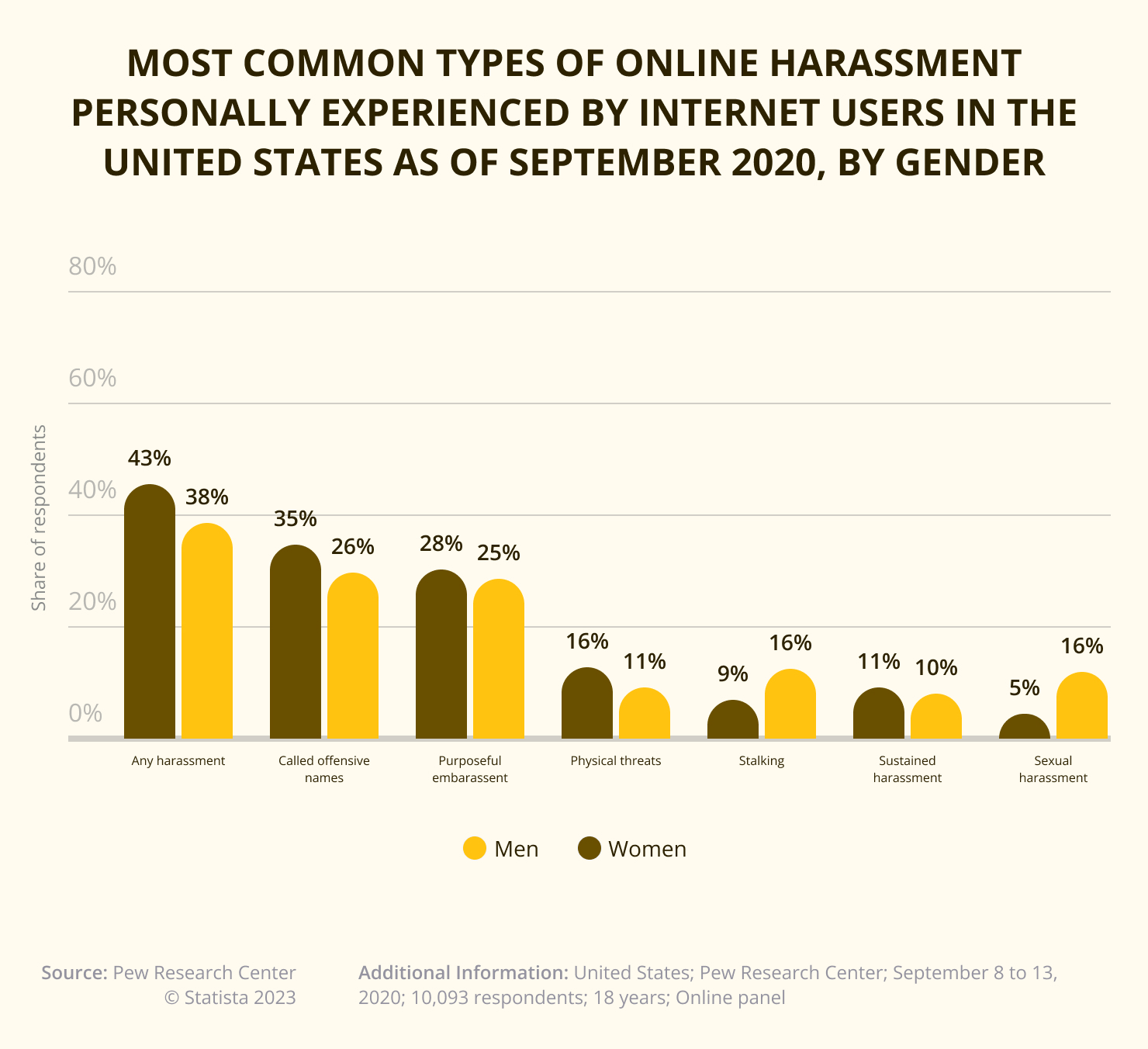
By Age Group
According to the 2020 survey[9] :
- 41% of all internet users in the United States have experienced some form of online harassment.
- Of those who were 18-29 years old, 64% reported any form of harassment.
That age group also tends to have the highest rate of sexual harassment, physical threats, stalking, sustained harassment, purposeful embarrassment, and even offensive name-calling. The next age group that tends to be affected by these various forms of cyberbullying would be those who are 30-49 years old.
Of those who have experienced sexual harassment:
- 25% were respondents ages 18-29.
- 4% were respondents ages 50+.
When it came to physical threats:
- 29% of those 18-29 years of age experienced this major problem.
- 5% of those over the age of 50 had experienced that same issue.
For stalking victims:
- 21% of those 18-29 years old experienced stalking.
- 4% of those ages greater than 50 years old experienced stalking.
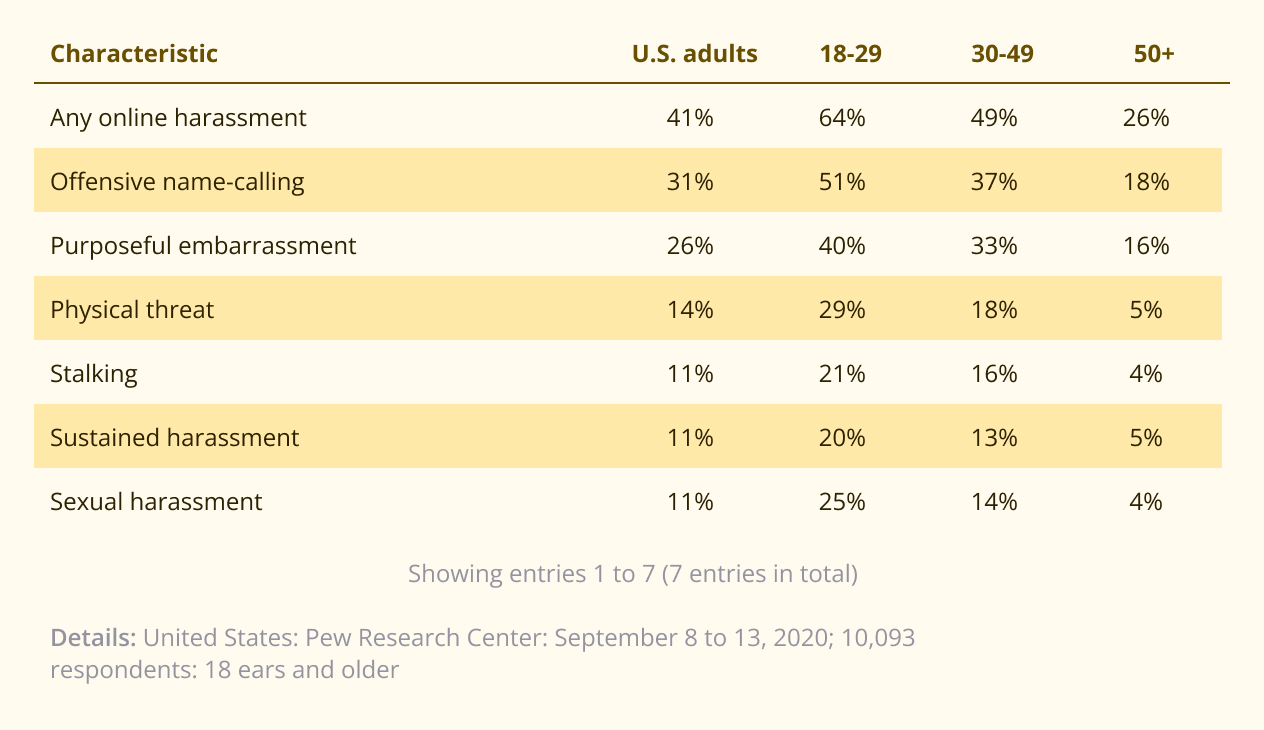
Reasons For Online Hate In U.S.
Many cyberbullying cases stem from various online hate sources.
- 55%[10] of the reasons for cyberbullying were due to political views.
- 25% experienced cyberbullying due to gender.
- 21% experienced cyberbullying due to religion.
- 35% was due to physical appearance.
Race and ethnicity was the reason for online hate for 25% of harassment victims. The other somewhat less common were based on occupation, disability, and sexual orientation.
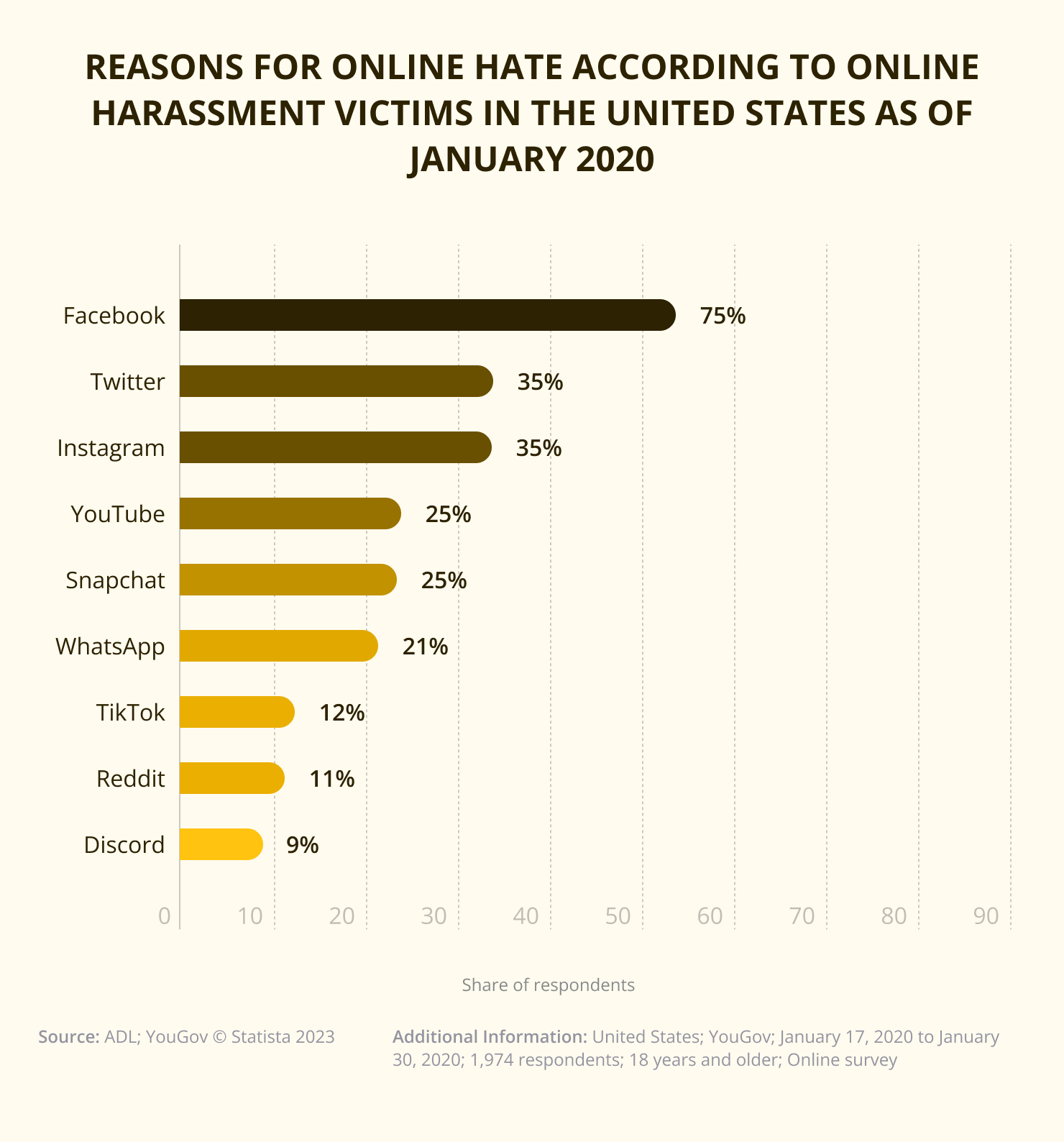
Prevention & Action On Online Harassment
U.S. States With State Cyber Bullying Laws
Due to cyberbullying prevalence and the various mental health issues that it can cause, social media companies and the U.S. government have worked to enact laws to stop cyberbullying.
- As of 2021, 48 states had online harassment laws[11] which addressed online abuse.
- 49 states in the United States have laws for school policy.
- 45 states have school sanctions for cyberbullying.
- 25 states had laws that also involved cyberbullying off campus.
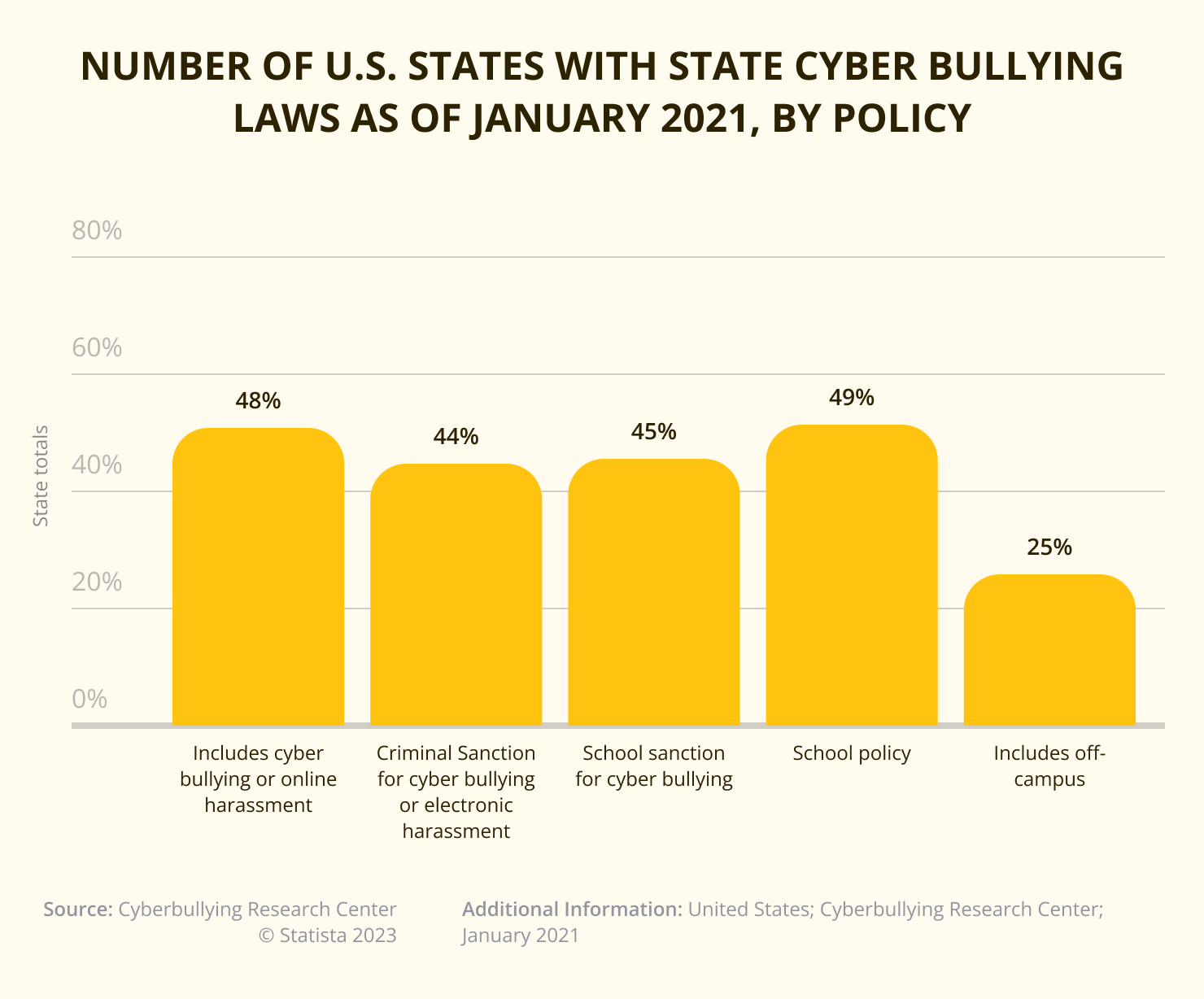
Actions To Prevent Cyberbullying
Individual companies are also taking preventive measures due to an increase in victims of cyberbullying. Based on Facebook reporting, the peak of action for taking down hate speech content was in the second quarter of 2021:
- 30.5 million pieces of hate speech[12] were removed.
- For the first quarter of 2023, there have already been 10.7 million pieces of hate speech taken down.
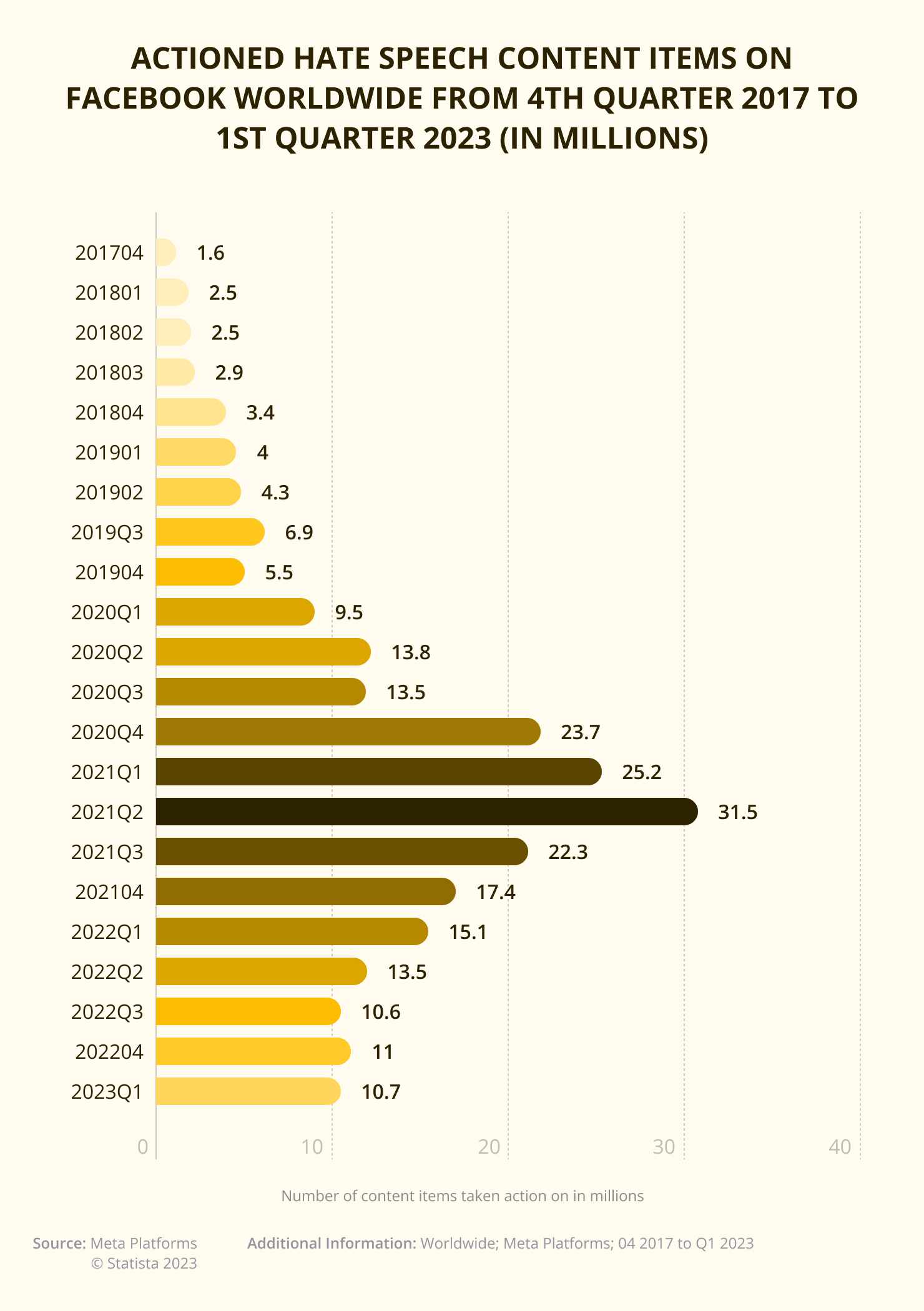
YouTube is also taking part in cleaning up its own platform.
- The fourth quarter of 2022 had 5.66 million videos[13] taken down worldwide.
- The peak was in the 2nd quarter of 2020, which included 11.4 million videos worldwide.
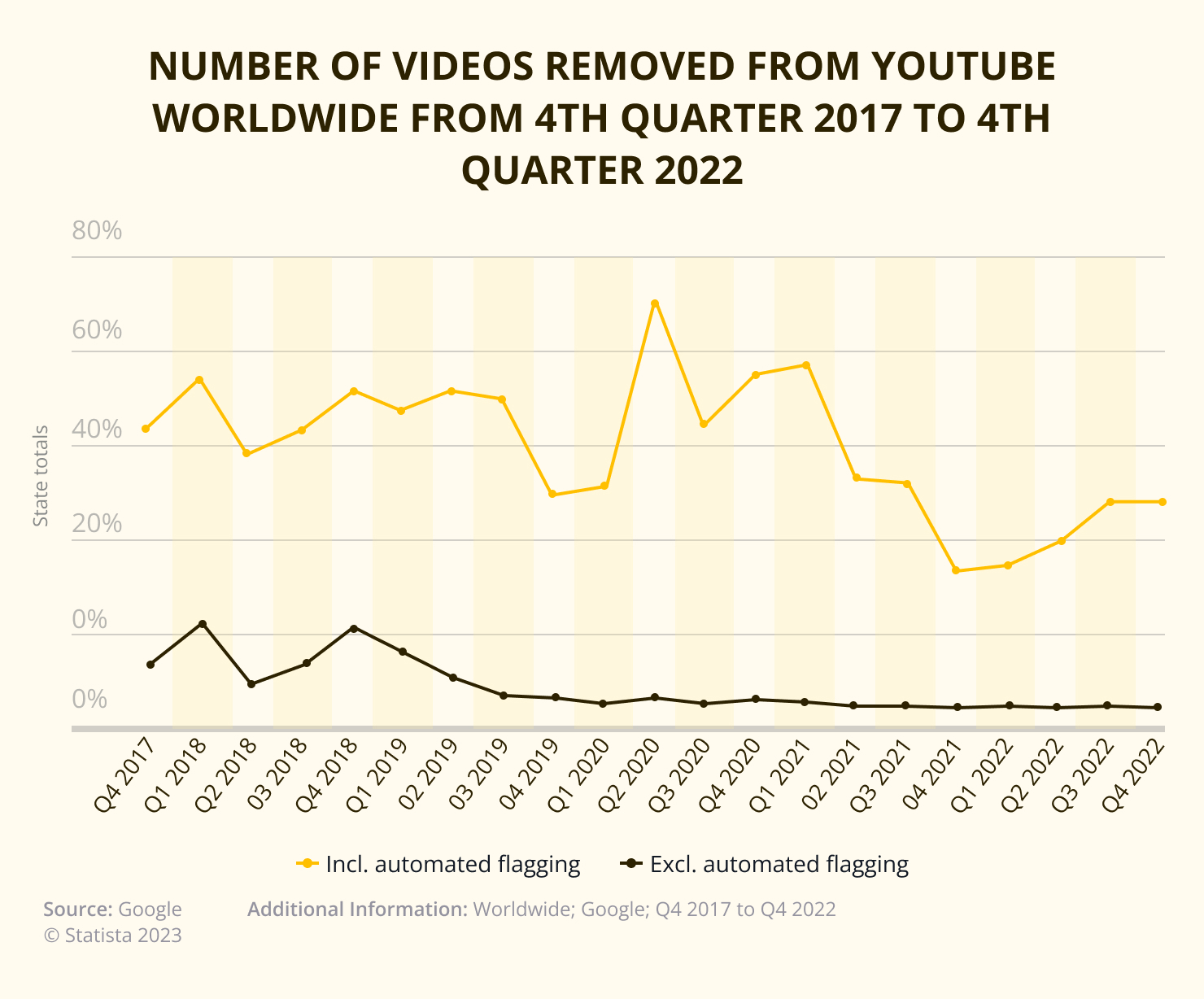
Conclusion
Cyberbullying is a new form of bullying that disproportionately affects young people and those of marginalized groups. Reported cyberbullying has had a detrimental effect on various demographic groups, such as women, and those of other ethnicities, ages, and religious ideologies. Social media tends to be the platform for a majority of cyberbullying statistics, and therefore social media companies have been involved in assisting with cyberstalking laws and internet safety legislation.
Any social network site can be a platform for hate speech. Therefore global awareness and robust legislation will pave the way to tackle cyberbullying. Therefore, internet safety should be of great concern, especially for the future generation of users.
Author Information
Yelena Wheeler
Health Writer & Registered Dietitian Nutritionist
Media Contact
Erik Pham
Founder of Health Canal
[email protected]